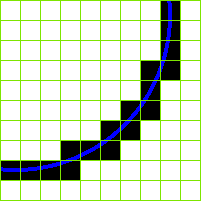sub-pixel resolution on:
[Wikipedia]
[Google]
[Amazon]
 In
In
 When an object with a certain resolution is represented on a display with lower resolution, the imperfections due to the loss of information are known as
When an object with a certain resolution is represented on a display with lower resolution, the imperfections due to the loss of information are known as
Accurate particle position measurement from images
. Y. Feng, J. Goree, and Bin Liu, ''Review of Scientific Instruments'', Vol. 78, 053704 (2007); also selected for ''Virtual Journal of Biological Physics Research'', Vol. 13, (2007).
digital image processing
Digital image processing is the use of a digital computer to process digital images through an algorithm. As a subcategory or field of digital signal processing, digital image processing has many advantages over analog image processing. It allo ...
, sub-pixel resolution can be obtained in images constructed from sources with information exceeding the nominal pixel resolution of said images.
Aliasing
 When an object with a certain resolution is represented on a display with lower resolution, the imperfections due to the loss of information are known as
When an object with a certain resolution is represented on a display with lower resolution, the imperfections due to the loss of information are known as aliasing
In signal processing and related disciplines, aliasing is an effect that causes different signals to become indistinguishable (or ''aliases'' of one another) when sampled. It also often refers to the distortion or artifact that results when a ...
.
This can happen with geometric objects, vector graphics
Vector graphics is a form of computer graphics in which visual images are created directly from geometric shapes defined on a Cartesian plane, such as points, lines, curves and polygons. The associated mechanisms may include vector display a ...
, vector fonts or 3D graphics
3D computer graphics, or “3D graphics,” sometimes called CGI, 3D-CGI or three-dimensional computer graphics are graphics that use a three-dimensional representation of geometric data (often Cartesian) that is stored in the computer for the ...
.
The most common kind of visual aliasing is when a smooth object such as a line appears jagged because the pixels are large enough to be easily distinguished by the naked eye.
These effects can be reduced by anti-aliasing Anti-aliasing may refer to any of a number of techniques to combat the problems of aliasing in a sampled signal such as a digital image or digital audio recording.
Specific topics in anti-aliasing include:
* Anti-aliasing filter, a filter used be ...
techniques, e.g. adjusting the colour or transparency of a pixel according to how much of it is covered by the object (sub-pixel rendering
In digital imaging, a pixel (abbreviated px), pel, or picture element is the smallest addressable element in a raster image, or the smallest point in an all points addressable display device.
In most digital display devices, pixels are the smal ...
).
Example
For example, if the image of a ship of length , viewed side-on, is 500 pixels long, the nominal resolution (pixel size) on the side of the ship facing the camera is . Now sub-pixel resolution of well resolved features can measure ship movements which are an order of magnitude (10×) smaller. Movement is specifically mentioned here because measuring absolute positions requires an accurate lens model and known reference points within the image to achieve sub-pixel position accuracy. Small movements can however be measured (down to 1 cm) with simple calibration procedures. Specific fit functions often suffer specific bias with respect to image pixel boundaries. Users should therefore take care to avoid these "pixel locking" (or "peak locking") effects.. Y. Feng, J. Goree, and Bin Liu, ''Review of Scientific Instruments'', Vol. 78, 053704 (2007); also selected for ''Virtual Journal of Biological Physics Research'', Vol. 13, (2007).
Determining feasibility
Whether features in a digital image are sharp enough to achieve sub-pixel resolution can be quantified by measuring the point spread function (PSF) of an isolated point in the image. If the image does not contain isolated points, similar methods can be applied to edges in the image. It is also important when attempting sub-pixel resolution to keep image noise to a minimum. This, in the case of a stationary scene, can be measured from a time series of images. Appropriate pixel averaging, through both time (for stationary images) and space (for uniform regions of the image) is often used to prepare the image for sub-pixel resolution measurements.Footnotes
References
# # # {{DEFAULTSORT:Sub-Pixel Resolution Image processing